Types of Energy Storage Inverters Energy storage inverters technology route: there are two major routes of DC coupling and AC coupling PV storage system, including solar modules, controllers, inverters, lithium home batteries, loads and other equipment. At present, energy storage inverters are mainly two technical routes: DC coupling and AC coupling. AC or DC coupling refers to the way solar panels are coupled or connected to the storage or battery system. The type of connection between solar modules and batteries can be either AC or DC. Most electronic circuits use DC power, with the solar module generating DC power and the battery storing DC power, however most appliances run on AC power. 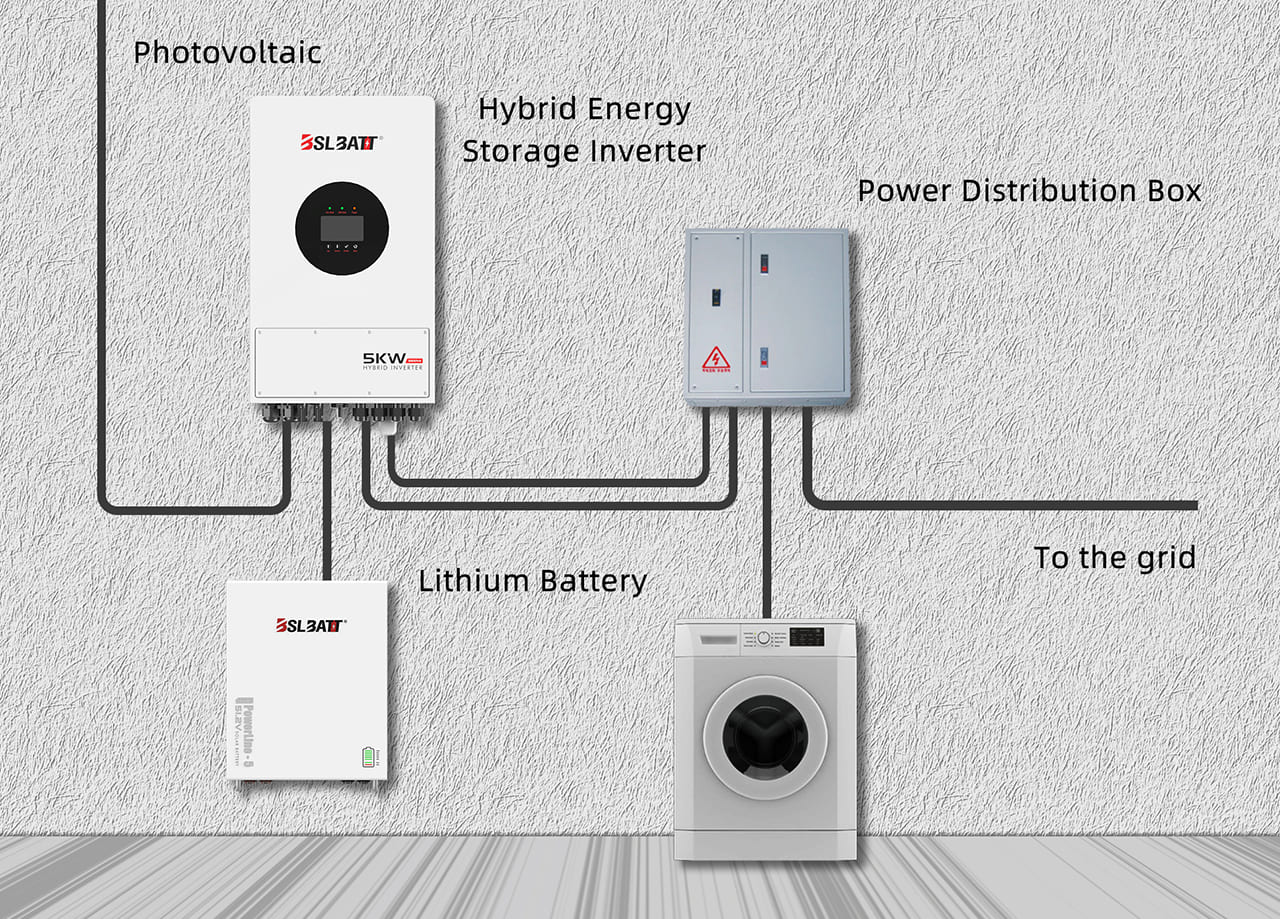 Hybrid Solar System + Energy Storage System Hybrid solar inverter + energy storage systems, where the DC power from the PV modules is stored, via a controller, in a lithium home battery bank, and the grid can also charge the battery via a bi-directional DC-AC converter. The point of convergence of energy is at the DC battery side. During the day, the PV power is first supplied to the load, and then the lithium home battery is charged by the MPPT controller, and the energy storage system is connected to the grid, so that the excess power can be connected to the grid; at night, the battery is discharged to the load, and the shortage is replenished by the grid; when the grid is out, the PV power and lithium home battery are only supplied to the off-grid load, and the load at the grid end cannot be used. When the load power is greater than the PV power, the grid and PV can supply power to the load at the same time. Because neither the PV power nor the load power is stable, it relies on the lithium home battery to balance the system energy. In addition, the system also supports the user to set the charging and discharging time to meet the user’s electricity demand. DC coupling system working principle
Hybrid Solar System + Energy Storage System Hybrid solar inverter + energy storage systems, where the DC power from the PV modules is stored, via a controller, in a lithium home battery bank, and the grid can also charge the battery via a bi-directional DC-AC converter. The point of convergence of energy is at the DC battery side. During the day, the PV power is first supplied to the load, and then the lithium home battery is charged by the MPPT controller, and the energy storage system is connected to the grid, so that the excess power can be connected to the grid; at night, the battery is discharged to the load, and the shortage is replenished by the grid; when the grid is out, the PV power and lithium home battery are only supplied to the off-grid load, and the load at the grid end cannot be used. When the load power is greater than the PV power, the grid and PV can supply power to the load at the same time. Because neither the PV power nor the load power is stable, it relies on the lithium home battery to balance the system energy. In addition, the system also supports the user to set the charging and discharging time to meet the user’s electricity demand. DC coupling system working principle  The hybrid inverter has an integrated off-grid function for improved charging efficiency. Grid-tied inverters automatically shut off power to the solar panel system during a power outage for safety reasons. Hybrid inverters, on the other hand, enable users to have both off-grid and grid-tied functionality, so power is available even during power outages. Hybrid inverters simplify energy monitoring, allowing important data such as performance and energy production to be checked through the inverter panel or connected smart devices. If the system has two inverters, they must be monitored separately. dC coupling reduces losses in AC-DC conversion. Battery charging efficiency is about 95-99%, while AC coupling is 90%. Hybrid inverters are economical, compact and easy to install. Installing a new hybrid inverter with DC-coupled batteries may be cheaper than retrofitting AC-coupled batteries to an existing system because the controller is somewhat cheaper than a grid-connected inverter, the switching switch is somewhat cheaper than a distribution cabinet, and the DC-coupled solution can be made into an all-in-one control inverter, saving both equipment costs and installation costs. Especially for small and medium power off-grid systems, DC-coupled systems are extremely cost-effective. The hybrid inverter is highly modular and it is easy to add new components and controllers, and additional components can be easily added using relatively low-cost DC solar controllers. The hybrid inverters are designed to integrate storage at any time, making it easier to add battery banks. The hybrid inverter system is more compact and uses high-voltage cells, with smaller cable sizes and lower losses.
The hybrid inverter has an integrated off-grid function for improved charging efficiency. Grid-tied inverters automatically shut off power to the solar panel system during a power outage for safety reasons. Hybrid inverters, on the other hand, enable users to have both off-grid and grid-tied functionality, so power is available even during power outages. Hybrid inverters simplify energy monitoring, allowing important data such as performance and energy production to be checked through the inverter panel or connected smart devices. If the system has two inverters, they must be monitored separately. dC coupling reduces losses in AC-DC conversion. Battery charging efficiency is about 95-99%, while AC coupling is 90%. Hybrid inverters are economical, compact and easy to install. Installing a new hybrid inverter with DC-coupled batteries may be cheaper than retrofitting AC-coupled batteries to an existing system because the controller is somewhat cheaper than a grid-connected inverter, the switching switch is somewhat cheaper than a distribution cabinet, and the DC-coupled solution can be made into an all-in-one control inverter, saving both equipment costs and installation costs. Especially for small and medium power off-grid systems, DC-coupled systems are extremely cost-effective. The hybrid inverter is highly modular and it is easy to add new components and controllers, and additional components can be easily added using relatively low-cost DC solar controllers. The hybrid inverters are designed to integrate storage at any time, making it easier to add battery banks. The hybrid inverter system is more compact and uses high-voltage cells, with smaller cable sizes and lower losses. 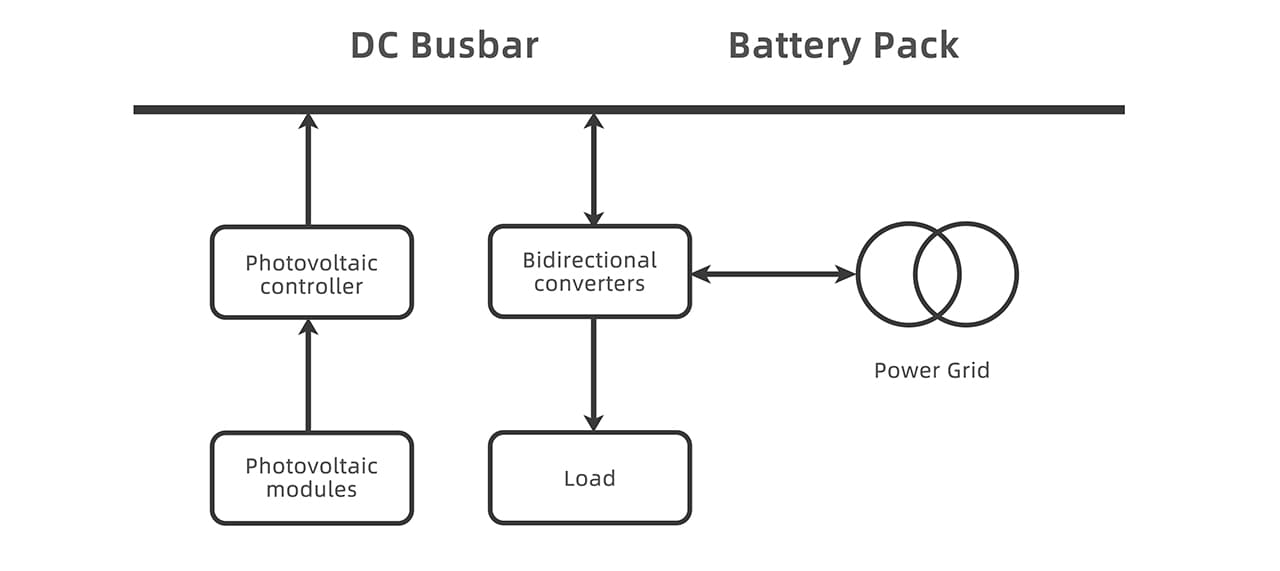 DC coupling system composition
DC coupling system composition 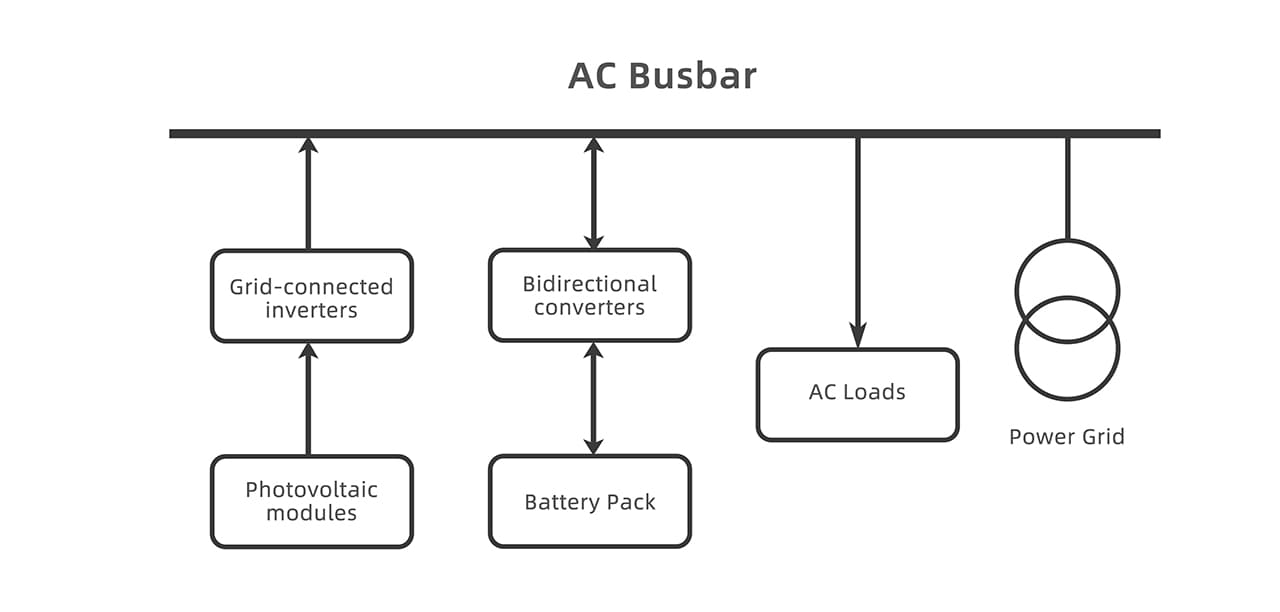 AC coupling system composition However, hybrid solar inverters are unsuitable for upgrading existing solar systems and are more expensive to install for higher power systems. If a customer wants to upgrade an existing solar system to include lithium home battery, choosing a hybrid solar inverter may complicate the situation. In contrast, a battery inverter may be more cost effective, as choosing to install a hybrid solar inverter would require a complete and expensive rework of the entire solar panel system. Higher power systems are more complex to install and can be more expensive due to the need for more high voltage controllers. If more power is used during the day, there is a slight decrease in efficiency due to DC (PV) to DC (batt) to AC.
AC coupling system composition However, hybrid solar inverters are unsuitable for upgrading existing solar systems and are more expensive to install for higher power systems. If a customer wants to upgrade an existing solar system to include lithium home battery, choosing a hybrid solar inverter may complicate the situation. In contrast, a battery inverter may be more cost effective, as choosing to install a hybrid solar inverter would require a complete and expensive rework of the entire solar panel system. Higher power systems are more complex to install and can be more expensive due to the need for more high voltage controllers. If more power is used during the day, there is a slight decrease in efficiency due to DC (PV) to DC (batt) to AC. 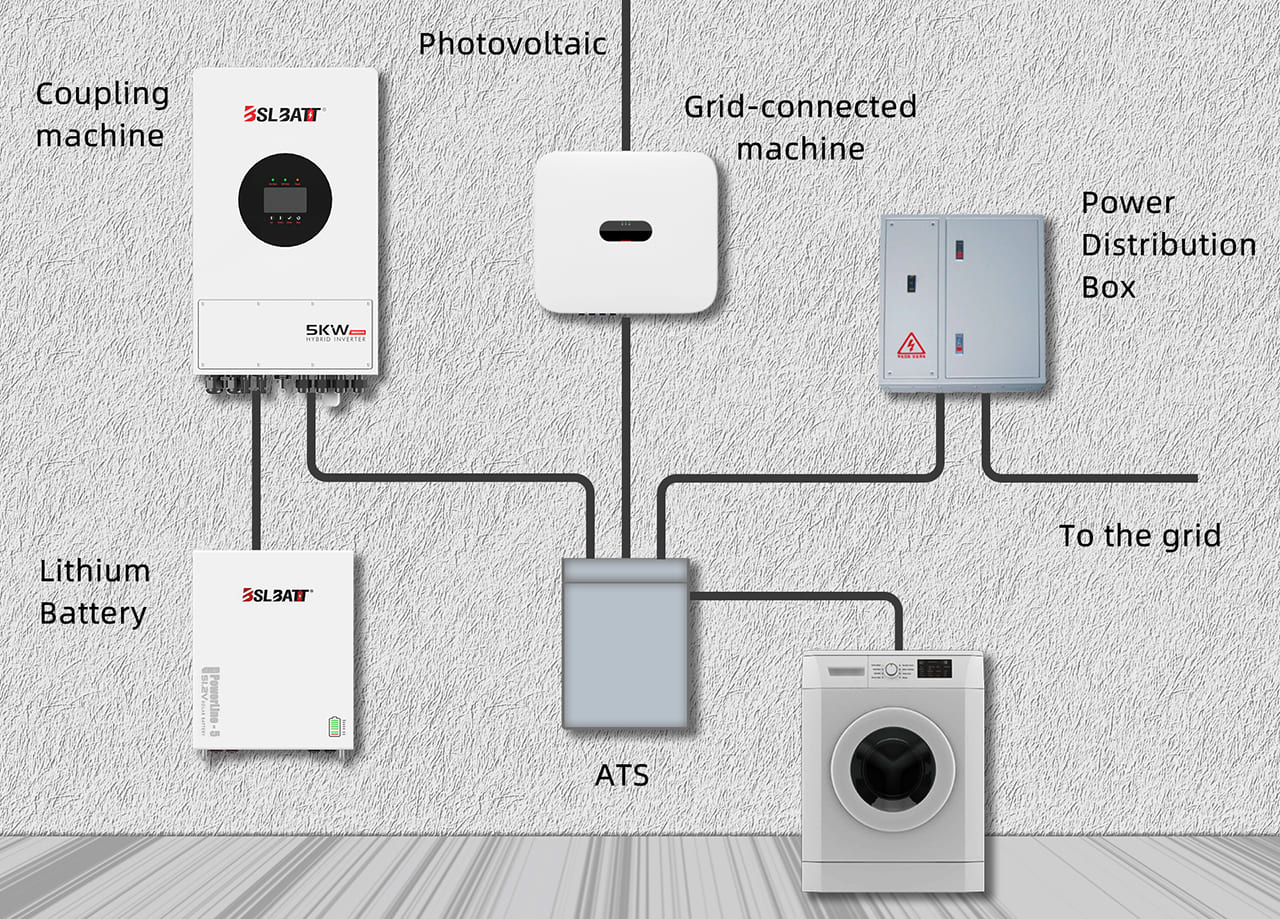 Coupled Solar System + Energy Storage System Coupled PV+storage system, also known as AC retrofit PV+storage system, can realize the DC power emitted from PV modules is converted into AC power by grid-connected inverter, and then the excess power is converted into DC power and stored in the battery by AC coupled storage inverter. The energy convergence point is at the AC end. It includes photovoltaic power supply system and lithium home battery power supply system. The photovoltaic system consists of a photovoltaic array and a grid-connected inverter, while the lithium home battery system consists of a battery bank and a bi-directional inverter. These two systems can either operate independently without interfering with each other or can be separated from the grid to form a microgrid system. AC coupling system working principle
Coupled Solar System + Energy Storage System Coupled PV+storage system, also known as AC retrofit PV+storage system, can realize the DC power emitted from PV modules is converted into AC power by grid-connected inverter, and then the excess power is converted into DC power and stored in the battery by AC coupled storage inverter. The energy convergence point is at the AC end. It includes photovoltaic power supply system and lithium home battery power supply system. The photovoltaic system consists of a photovoltaic array and a grid-connected inverter, while the lithium home battery system consists of a battery bank and a bi-directional inverter. These two systems can either operate independently without interfering with each other or can be separated from the grid to form a microgrid system. AC coupling system working principle 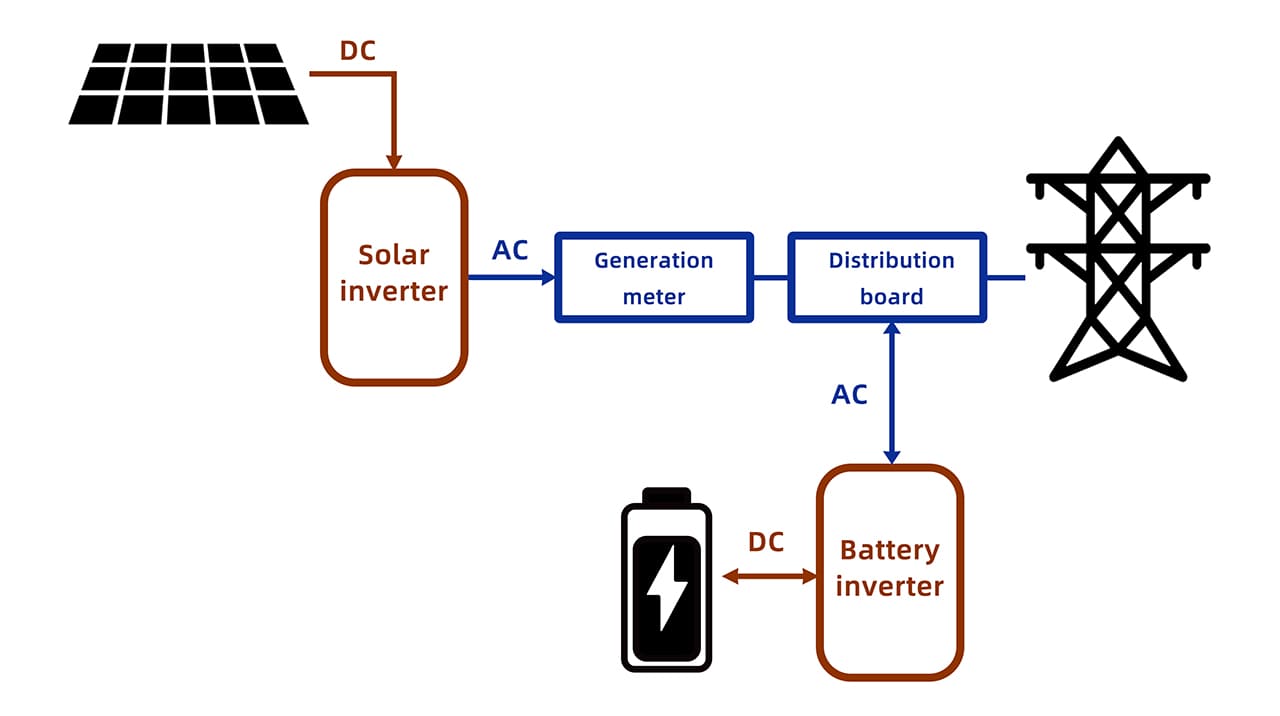 AC coupled systems are 100% grid compatible, easy to install and easily expandable. Standard home installation components are available, and even relatively large systems (2kW to MW class) are easily expandable for use in combination with grid-tied and stand-alone generator sets (diesel sets, wind turbines, etc.). Most string solar inverters above 3kW have dual MPPT inputs, so long string panels can be mounted in different orientations and tilt angles. At higher DC voltages, AC coupling is easier and less complex to install large systems than DC coupled systems that require multiple MPPT charge controllers, and therefore less costly. AC coupling is suitable for system retrofitting and is more efficient during the day with AC loads. Existing grid-connected PV systems can be transformed into energy storage systems with low input costs. It can provide safe power to users when the power grid is out. Compatible with grid-connected PV systems of different manufacturers. Advanced AC coupled systems are typically used for larger scale off-grid systems and use string solar inverters in combination with advanced multi-mode inverters or inverter/chargers to manage the batteries and grid/generators. Although relatively simple and powerful to set up, they are slightly less efficient (90-94%) at charging batteries compared to DC-coupled systems (98%). However, these systems are more efficient when powering high AC loads during the day, reaching 97% or more, and some can be expanded with multiple solar inverters to form microgrids. AC-coupled charging is much less efficient and more expensive for smaller systems. The energy entering the battery in AC coupling must be converted twice, and when the user starts using the energy, it must be converted again, adding more losses to the system. As a result, the AC coupling efficiency drops to 85-90% when using a battery system. AC-coupled inverters are more expensive for smaller systems.
AC coupled systems are 100% grid compatible, easy to install and easily expandable. Standard home installation components are available, and even relatively large systems (2kW to MW class) are easily expandable for use in combination with grid-tied and stand-alone generator sets (diesel sets, wind turbines, etc.). Most string solar inverters above 3kW have dual MPPT inputs, so long string panels can be mounted in different orientations and tilt angles. At higher DC voltages, AC coupling is easier and less complex to install large systems than DC coupled systems that require multiple MPPT charge controllers, and therefore less costly. AC coupling is suitable for system retrofitting and is more efficient during the day with AC loads. Existing grid-connected PV systems can be transformed into energy storage systems with low input costs. It can provide safe power to users when the power grid is out. Compatible with grid-connected PV systems of different manufacturers. Advanced AC coupled systems are typically used for larger scale off-grid systems and use string solar inverters in combination with advanced multi-mode inverters or inverter/chargers to manage the batteries and grid/generators. Although relatively simple and powerful to set up, they are slightly less efficient (90-94%) at charging batteries compared to DC-coupled systems (98%). However, these systems are more efficient when powering high AC loads during the day, reaching 97% or more, and some can be expanded with multiple solar inverters to form microgrids. AC-coupled charging is much less efficient and more expensive for smaller systems. The energy entering the battery in AC coupling must be converted twice, and when the user starts using the energy, it must be converted again, adding more losses to the system. As a result, the AC coupling efficiency drops to 85-90% when using a battery system. AC-coupled inverters are more expensive for smaller systems. 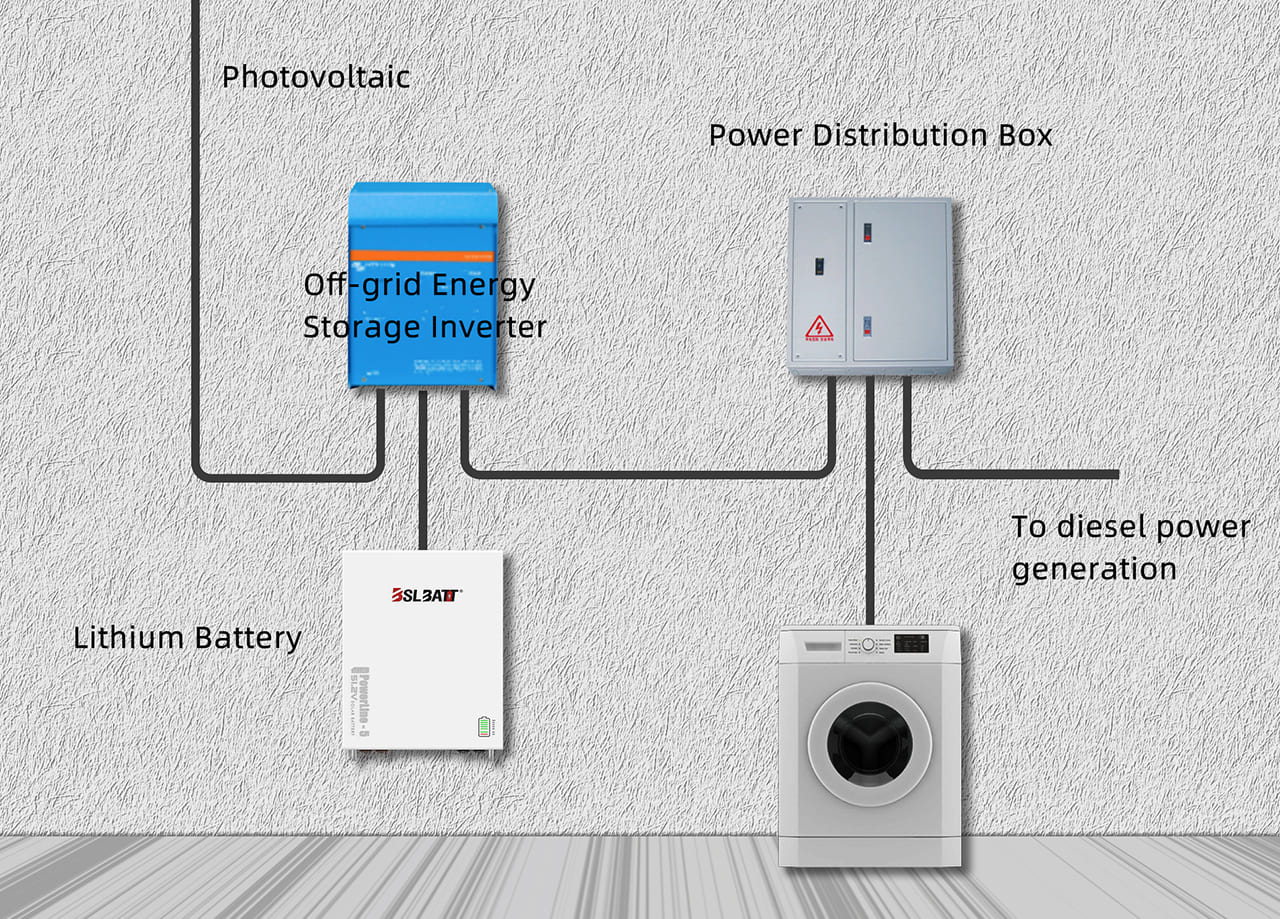 Off-grid Solar System + Energy Storage System Off-grid solar system + storage systems typically consist of PV modules, lithium home battery, off-grid storage inverter, load and diesel generator. The system can realize direct charging of the battery by PV via DC-DC conversion, or bi-directional DC-AC conversion for charging and discharging the battery. During the daytime, the PV power is firstly supplied to the load, followed by charging the battery; at night, the battery is discharged to the load, and when the battery is insufficient, the diesel generator is supplied to the load. It can meet the daily electricity demand in areas without grid. It can be combined with diesel generators to supply loads or charge batteries. Most off-grid energy storage inverters are not certified to be grid-connected, even if the system has a grid, it cannot be grid-connected. Applicable Scenarios of Energy Storage Inverters Energy storage inverters have three major roles, including peak regulation, standby power and independent power. By region, peaking is the demand in Europe, take Germany as an example, the price of electricity in Germany has reached $0.46/kWh in 2023, ranking first in the world. In recent years, German electricity prices continue to rise, and PV / PV storage LCOE is only 10.2 / 15.5 cents per degree, 78% / 66% lower than the residential electricity prices, residential electricity prices and PV storage cost of electricity between the difference will continue to widen. Household PV distribution and storage system can reduce the cost of electricity, so in high price areas users have a strong incentive to install household storage. In the peaking market, users tend to choose hybrid inverters and AC-coupled battery systems, which are more cost-effective and easier to manufacture. Off-grid battery inverter chargers with heavy-duty transformers are more expensive, while hybrid inverters and AC-coupled battery systems use transformerless inverters with switching transistors. These compact, lightweight inverters have lower surge and peak power output ratings, but are more cost effective, cheaper and easier to manufacture. Backup power is needed in the U.S. and Japan, and stand-alone power is just what the market needs, including in regions such as South Africa. According to the EIA, the average power outage time in the United States in 2020 is more than 8 hours, mainly by the U.S. residents living in scattered, part of the aging grid and natural disasters. The application of household PV distribution and storage systems can reduce the dependence on the grid and increase the reliability of power supply on the customer side. The U.S. PV storage system is larger and equipped with more batteries, because the need to store power in response to natural disasters. Independent power supply is the immediate market demand, South Africa, Pakistan, Lebanon, the Philippines, Vietnam and other countries in the global supply chain tension, the country’s infrastructure is not enough to support the population with electricity, so users to be equipped with household PV storage system. Hybrid inverters as backup power have limitations. Compared to dedicated off-grid battery inverters, hybrid inverters have some limitations, mainly limited surge or peak power output in case of power outages. In addition, some hybrid inverters have no or limited backup power capability, so only small or essential loads such as lighting and basic power circuits can be backed up during a power outage, and many systems experience a 3-5 second delay during a power outage. Off-grid inverters, on the other hand, provide very high surge and peak power output and can handle high inductive loads. If the user plans to power high-surge devices such as pumps, compressors, washing machines and power tools, the inverter must be able to handle high-inductance surge loads. DC-coupled hybrid inverters The industry is currently using more PV storage systems with DC coupling to achieve integrated PV storage design, especially in new systems where hybrid inverters are easy and less costly to install. When adding new systems, the use of hybrid inverters for PV energy storage can reduce equipment costs and installation costs, because a storage inverter can achieve control-inverter integration. The controller and switching switch in DC-coupled systems are less expensive than grid-connected inverters and distribution cabinets in AC-coupled systems, so DC-coupled solutions are less costly than AC-coupled solutions. The controller, battery and inverter in DC-coupled system are serial, connected more closely and less flexible. For the newly installed system, PV, battery and inverter are designed according to the user’s load power and power consumption, so it is more suitable for DC-coupled hybrid inverter.
Off-grid Solar System + Energy Storage System Off-grid solar system + storage systems typically consist of PV modules, lithium home battery, off-grid storage inverter, load and diesel generator. The system can realize direct charging of the battery by PV via DC-DC conversion, or bi-directional DC-AC conversion for charging and discharging the battery. During the daytime, the PV power is firstly supplied to the load, followed by charging the battery; at night, the battery is discharged to the load, and when the battery is insufficient, the diesel generator is supplied to the load. It can meet the daily electricity demand in areas without grid. It can be combined with diesel generators to supply loads or charge batteries. Most off-grid energy storage inverters are not certified to be grid-connected, even if the system has a grid, it cannot be grid-connected. Applicable Scenarios of Energy Storage Inverters Energy storage inverters have three major roles, including peak regulation, standby power and independent power. By region, peaking is the demand in Europe, take Germany as an example, the price of electricity in Germany has reached $0.46/kWh in 2023, ranking first in the world. In recent years, German electricity prices continue to rise, and PV / PV storage LCOE is only 10.2 / 15.5 cents per degree, 78% / 66% lower than the residential electricity prices, residential electricity prices and PV storage cost of electricity between the difference will continue to widen. Household PV distribution and storage system can reduce the cost of electricity, so in high price areas users have a strong incentive to install household storage. In the peaking market, users tend to choose hybrid inverters and AC-coupled battery systems, which are more cost-effective and easier to manufacture. Off-grid battery inverter chargers with heavy-duty transformers are more expensive, while hybrid inverters and AC-coupled battery systems use transformerless inverters with switching transistors. These compact, lightweight inverters have lower surge and peak power output ratings, but are more cost effective, cheaper and easier to manufacture. Backup power is needed in the U.S. and Japan, and stand-alone power is just what the market needs, including in regions such as South Africa. According to the EIA, the average power outage time in the United States in 2020 is more than 8 hours, mainly by the U.S. residents living in scattered, part of the aging grid and natural disasters. The application of household PV distribution and storage systems can reduce the dependence on the grid and increase the reliability of power supply on the customer side. The U.S. PV storage system is larger and equipped with more batteries, because the need to store power in response to natural disasters. Independent power supply is the immediate market demand, South Africa, Pakistan, Lebanon, the Philippines, Vietnam and other countries in the global supply chain tension, the country’s infrastructure is not enough to support the population with electricity, so users to be equipped with household PV storage system. Hybrid inverters as backup power have limitations. Compared to dedicated off-grid battery inverters, hybrid inverters have some limitations, mainly limited surge or peak power output in case of power outages. In addition, some hybrid inverters have no or limited backup power capability, so only small or essential loads such as lighting and basic power circuits can be backed up during a power outage, and many systems experience a 3-5 second delay during a power outage. Off-grid inverters, on the other hand, provide very high surge and peak power output and can handle high inductive loads. If the user plans to power high-surge devices such as pumps, compressors, washing machines and power tools, the inverter must be able to handle high-inductance surge loads. DC-coupled hybrid inverters The industry is currently using more PV storage systems with DC coupling to achieve integrated PV storage design, especially in new systems where hybrid inverters are easy and less costly to install. When adding new systems, the use of hybrid inverters for PV energy storage can reduce equipment costs and installation costs, because a storage inverter can achieve control-inverter integration. The controller and switching switch in DC-coupled systems are less expensive than grid-connected inverters and distribution cabinets in AC-coupled systems, so DC-coupled solutions are less costly than AC-coupled solutions. The controller, battery and inverter in DC-coupled system are serial, connected more closely and less flexible. For the newly installed system, PV, battery and inverter are designed according to the user’s load power and power consumption, so it is more suitable for DC-coupled hybrid inverter. 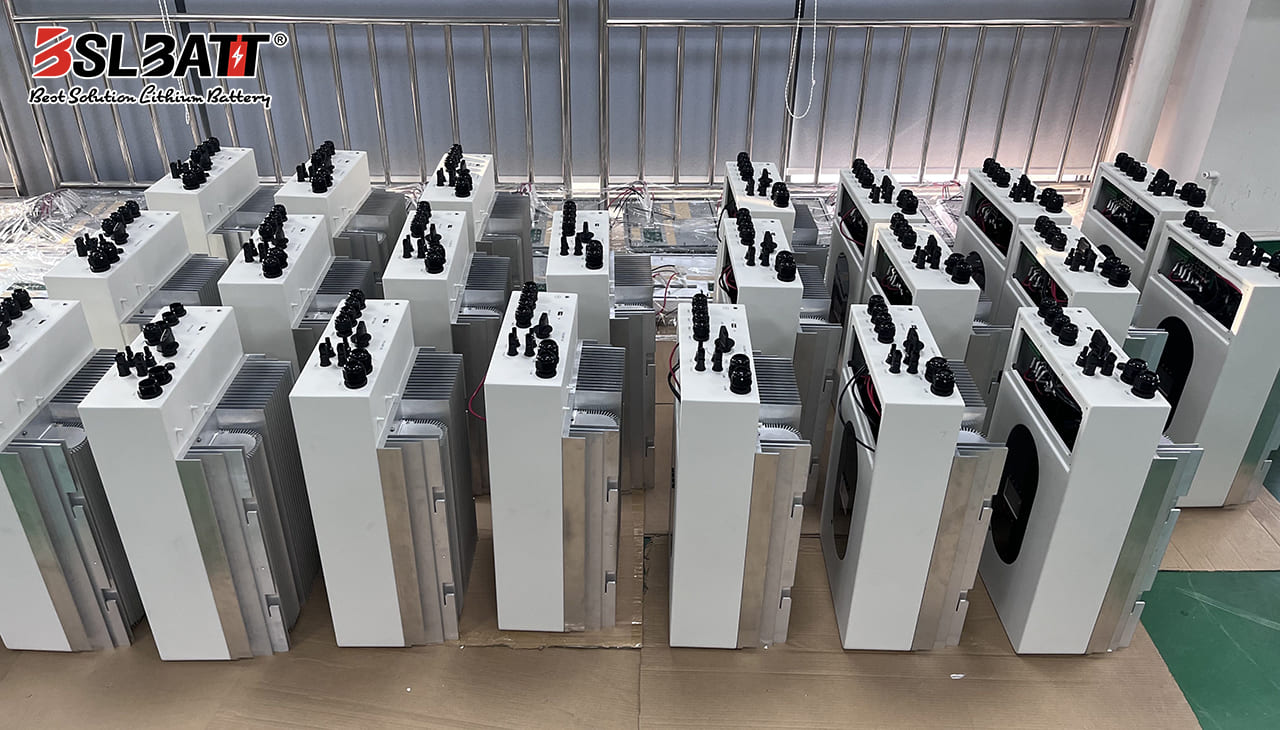 DC-coupled hybrid inverter products are the mainstream trend, BSLBATT also launched its own 5kw hybrid solar inverter at the end of last year, and will launch 6kW and 8kW hybrid solar inverters successively this year! The main products of energy storage inverter manufacturers are more for the three major markets of Europe, the United States and Australia. In the European market, Germany, Austria, Switzerland, Sweden, the Netherlands and other traditional PV core market is mainly three-phase market, more favorable to the power of larger products. Italy, Spain and other southern European countries mainly need single-phase low-voltage products. And the Czech Republic, Poland, Romania, Lithuania and other Eastern European countries mainly demand for three-phase products, but the price acceptance is lower. The United States has a larger energy storage system and prefers higher power products. Battery and storage inverter split type is more popular with installers, but battery inverter all-in-one is the future development trend. PV energy storage hybrid inverter is further divided into hybrid inverter sold separately and battery energy storage system (BESS) which sells the energy storage inverter and battery together. At present, in the case of dealers in control of the channel, each direct customers are more concentrated, the battery, inverter split products are more popular, especially outside Germany, mainly because of easy installation and easy expansion, and easy to reduce procurement costs, the battery or inverter can not be supplied to find a second supply, delivery is more secure. Germany, the United States, Japan trend is an all-in-one machine. All-in-one machine can save a lot of trouble after the sale, and there are factors of certification, such as the United States fire system certification needs to be linked to the inverter. The current technology trend is going to the all-in-one machine, but from the market sales of split type in the installer to accept a little more. In DC coupled systems, high voltage battery systems are more efficient, but more costly in the case of high voltage battery shortage. Compared to 48V battery systems, high-voltage batteries operate in the 200-500V DC range, have lower cable losses and higher efficiency because solar panels typically operate at 300-600V, similar to the battery voltage, allowing the use of high-efficiency DC-DC converters with very low losses. High-voltage battery systems are more expensive than low-voltage system batteries, while inverters are less expensive. Currently there is a high demand for high voltage batteries and a shortage of supply, so high voltage batteries are difficult to purchase, and in the case of a shortage of high voltage batteries, it is cheaper to use a low voltage battery system. DC coupling between solar arrays and inverters
DC-coupled hybrid inverter products are the mainstream trend, BSLBATT also launched its own 5kw hybrid solar inverter at the end of last year, and will launch 6kW and 8kW hybrid solar inverters successively this year! The main products of energy storage inverter manufacturers are more for the three major markets of Europe, the United States and Australia. In the European market, Germany, Austria, Switzerland, Sweden, the Netherlands and other traditional PV core market is mainly three-phase market, more favorable to the power of larger products. Italy, Spain and other southern European countries mainly need single-phase low-voltage products. And the Czech Republic, Poland, Romania, Lithuania and other Eastern European countries mainly demand for three-phase products, but the price acceptance is lower. The United States has a larger energy storage system and prefers higher power products. Battery and storage inverter split type is more popular with installers, but battery inverter all-in-one is the future development trend. PV energy storage hybrid inverter is further divided into hybrid inverter sold separately and battery energy storage system (BESS) which sells the energy storage inverter and battery together. At present, in the case of dealers in control of the channel, each direct customers are more concentrated, the battery, inverter split products are more popular, especially outside Germany, mainly because of easy installation and easy expansion, and easy to reduce procurement costs, the battery or inverter can not be supplied to find a second supply, delivery is more secure. Germany, the United States, Japan trend is an all-in-one machine. All-in-one machine can save a lot of trouble after the sale, and there are factors of certification, such as the United States fire system certification needs to be linked to the inverter. The current technology trend is going to the all-in-one machine, but from the market sales of split type in the installer to accept a little more. In DC coupled systems, high voltage battery systems are more efficient, but more costly in the case of high voltage battery shortage. Compared to 48V battery systems, high-voltage batteries operate in the 200-500V DC range, have lower cable losses and higher efficiency because solar panels typically operate at 300-600V, similar to the battery voltage, allowing the use of high-efficiency DC-DC converters with very low losses. High-voltage battery systems are more expensive than low-voltage system batteries, while inverters are less expensive. Currently there is a high demand for high voltage batteries and a shortage of supply, so high voltage batteries are difficult to purchase, and in the case of a shortage of high voltage batteries, it is cheaper to use a low voltage battery system. DC coupling between solar arrays and inverters  DC direct coupling to a compatible hybrid inverter
DC direct coupling to a compatible hybrid inverter 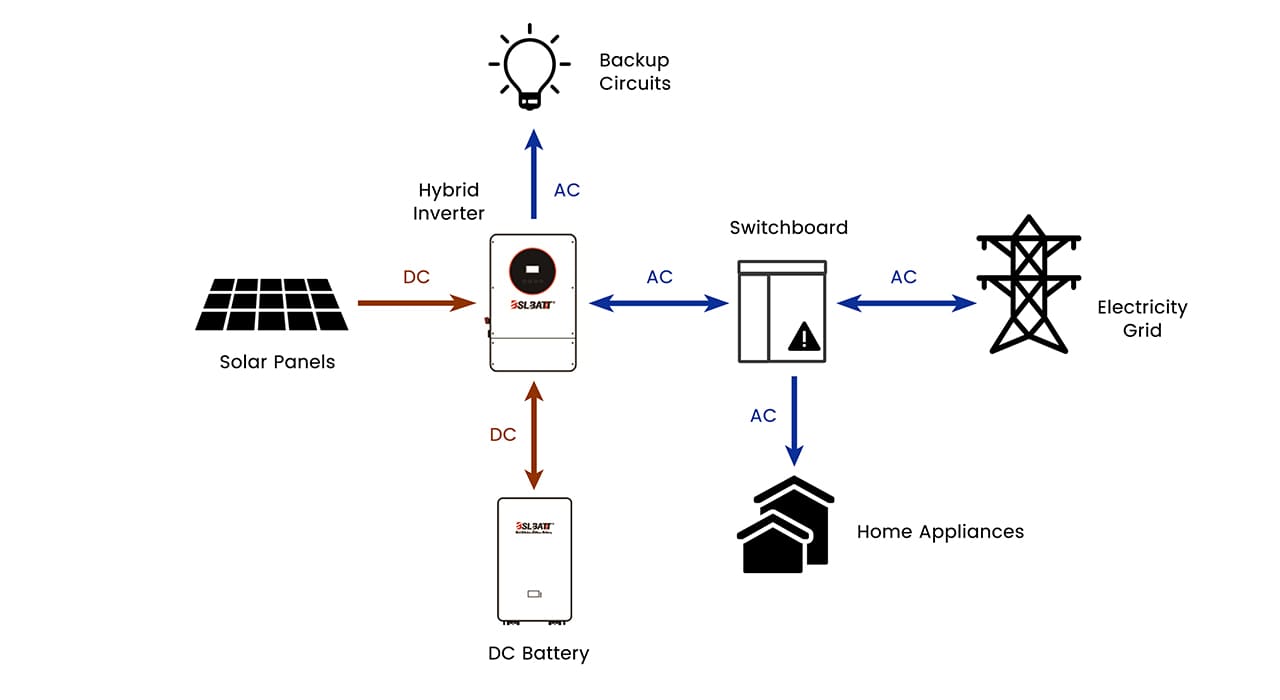 AC Coupled Inverters DC-coupled systems are not suitable for retrofitting existing grid-connected systems. The DC coupling method mainly has the following problems: First, the system using DC coupling has the problems of complicated wiring and redundant module design when retrofitting the existing grid-connected system; second, the delay in switching between grid-connected and off-grid is long, which makes the user’s electricity experience poor; third, the intelligent control function is not comprehensive enough and the response of control is not timely enough, which makes it more difficult to realize the micro-grid application of whole-house power supply. Therefore, some companies have chosen the AC coupling technology route, such as Rene. AC coupling system makes the product installation easier. ReneSola uses the AC side and PV system coupling to achieve bi-directional energy flow, eliminating the need for access to the PV DC bus, making product installation easier; through a combination of software real-time control and hardware design improvements to achieve millisecond switchover to and from the grid; through the innovative combination of energy storage inverter output control and power supply and distribution system design to achieve a whole-house power supply under automatic control box control The micro-grid application of the automatic control box control. The maximum conversion efficiency of AC coupled products is slightly lower than that of hybrid inverters. The maximum conversion efficiency of AC coupled products is 94-97%, which is slightly lower than that of hybrid inverters, mainly because the modules have to be converted twice before they can be stored in the battery after power generation, which reduces the conversion efficiency.
AC Coupled Inverters DC-coupled systems are not suitable for retrofitting existing grid-connected systems. The DC coupling method mainly has the following problems: First, the system using DC coupling has the problems of complicated wiring and redundant module design when retrofitting the existing grid-connected system; second, the delay in switching between grid-connected and off-grid is long, which makes the user’s electricity experience poor; third, the intelligent control function is not comprehensive enough and the response of control is not timely enough, which makes it more difficult to realize the micro-grid application of whole-house power supply. Therefore, some companies have chosen the AC coupling technology route, such as Rene. AC coupling system makes the product installation easier. ReneSola uses the AC side and PV system coupling to achieve bi-directional energy flow, eliminating the need for access to the PV DC bus, making product installation easier; through a combination of software real-time control and hardware design improvements to achieve millisecond switchover to and from the grid; through the innovative combination of energy storage inverter output control and power supply and distribution system design to achieve a whole-house power supply under automatic control box control The micro-grid application of the automatic control box control. The maximum conversion efficiency of AC coupled products is slightly lower than that of hybrid inverters. The maximum conversion efficiency of AC coupled products is 94-97%, which is slightly lower than that of hybrid inverters, mainly because the modules have to be converted twice before they can be stored in the battery after power generation, which reduces the conversion efficiency.
Post time: May-08-2024








